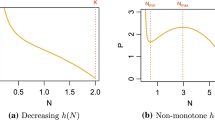Abstract
Predator-prey models where one or more terms involve ratios of the predator and prey populations may not be valid mathematically unless it can be shown that solutions with positive initial conditions never get arbitrarily close to the axis in question, i.e. that persistence holds. By means of a transformation of variables, criteria for persistence are derived for two classes of such models, thereby leading to their validity. Although local extinction certainly is a common occurrence in nature, it cannot be modeled by systems which are ratio-dependent near the axes.
Similar content being viewed by others
Literature
Arditi, R. and L. R. Ginzburg. 1989. Coupling in predator-prey dynamics: ratio dependence.J. theor. Biol. 139, 311–326.
Butler, G., H. I. Freedman and P. Waltman. 1986. Uniformly persistent systems.Proc. Am. Math. Soc. 96, 425–429.
Butler, G. and P. Waltman. 1986. Persistence in dynamical systems.J. Differential Equations 63, 255–263.
Freedman, H. I. 1980.Deterministic Mathematical Models in Population Ecology. New York: Marcel Dekker.
Freedman, H. I. and P. Moson. 1990. Persistence definitions and their connections.Proc. Am. Math. Soc. 109, 1025–1033.
Freedman, H. I. and P. Waltman. 1984. Persistence in models of three interacting predator-prey populations.Math. Biosci. 68, 213–231.
Freedman, H. I. and P. Waltman. 1985. Persistence in a model of three competitive populations.Math. Biosci. 73, 89–101.
Gard, T. C. 1987. Uniform persistence in multispecies population models.Math. Biosci. 85, 93–104.
Gause, G. F., N. P. Smaragdova and A. A. Witt. 1936. Further studies of interaction between predators and prey.J. Anim. Ecol. 5, 1–18.
Lindstrom, T. Preprint. Qualitative analysis of a predator-prey system with limit cycles.
Karkar, A. K., D. Mitra, S. Ray and A. B. Roy. 1991. Permanence and oscillatory coexistence of a detrius-based prey-predator model.Ecol. Model 53, 147–156.
Veilleux, B. G. 1979. An analysis between the predatory interaction between paramecium and didinium.J. Anim. Ecol. 48, 787–803.
Wiens, J. A., J. F. Addicott, T. J. Case and J. Diamond. 1986. Overview: the importance of spatial and temporal scale in ecological investigations. In:Community Ecology. J. Diamond and T. J. Case (Eds), pp. 145–153. New York: Harper and Row.
Author information
Authors and Affiliations
Additional information
Research partially supported by the Natural Sciences and Engineering Research Council of Canada, Grant No. NSERC A4823.
Research carried out while visiting the University of Alberta.
Rights and permissions
About this article
Cite this article
Freedman, H.I., Mathsen, R.M. Persistence in predator-prey systems with ratio-dependent predator influence. Bltn Mathcal Biology 55, 817–827 (1993). https://doi.org/10.1007/BF02460674
Received:
Issue Date:
DOI: https://doi.org/10.1007/BF02460674




